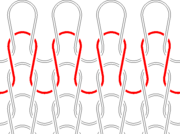The topology of a knit fabric is relatively complex. Unlike woven fabrics, where strands usually run straight horizontally and vertically, yarn that has been knit follows a loopy path along its row, as with the red strand in this diagram:

Schematic of stockinette stitch, the most basic weft-knit fabric
The loops of one row have all been pulled through the loops of the row below it.
Because there is no single straight line of yarn anywhere in the pattern, a knit piece will be stretchy in all directions (some more than others, depending on the yarn fiber and the specific pattern used). This stretchiness, unavailable from woven fabrics (which only stretch along the bias), is what originally made knitting so suitable for stockings. Many modern stretchy garments, even as they rely on elastic synthetic materials for some stretch, also achieve at least some of their stretch through knit patterns.
The basic knit fabric (as in the diagram, and usually called a stocking or stockinette pattern) has a definite right side and wrong side. On the right side, the visible portions of the loops are the verticals connecting two rows, arranged in a grid of V shapes. On the wrong side, the ends of the loops are visible, both the tops and bottoms, creating a much more bumpy texture sometimes called reverse stockinette (despite being the "wrong side," reverse stockinette is frequently used as a pattern in its own right). Because the yarn holding rows together is all on the front, and the yarn holding side-by-side stitches together is all on the back, stockinette fabric has a strong tendency to curl toward the front on the top and bottom, and toward the back on the left and right side.
Stitches can be worked from either side, and many patterns are created by mixing regular knit stitches with the "wrong side" stitches, known as purl stitches, either in columns (ribbing), rows (garter or welting), or more complex patterns. Each such fabric has different properties: a garter stitch has much more vertical stretch, while ribbing stretches much more horizontally. Because of their front-back symmetry, these two fabrics have little curl, making them popular as edging, even when their stretch properties are not desired.
Different combinations of knit and purl stitches, along with more advanced techniques, generate fabrics of considerably variable consistency, from gauzy to very dense, from highly stretchy to relatively stiff, from flat to tightly curled, and so on.
Texture
The canonical default texture for a knit garment is that generated by the flat stockinette stitch—as seen, though very small, in machine-made stockings and t-shirts—which is worked in the round as nothing but knit stitches, and worked flat as alternating rows of knit and purl. Other simple textures can be made with nothing but knit and purl stitches, including garter stitch, ribbing, and moss and seed stitches. Adding a "slip stitch" (just moving a loop from one needle to the other, without working it) allows for a wide range of textures, including heel and linen stitches, and a number of more complicated patterns.
Some more advanced knitting techniques create a surprising variety of complex textures. Combining "yarn-over" increases (which create small eyelet holes in the resulting fabric) with assorted decreases (e.g. by knitting two stitches together) is key to lace knitting, a very open fabric resembling lace. Changing the order of stitches from one row to the next, usually with the help of a cable needle or stitch holder, is key to cable knitting, producing an endless variety of cables, honeycombs, ropes, and other Aran sweater patterning. Entrelac forms a rich checkerboard texture by knitting small squares, picking up their side edges, and knitting more squares to continue the piece.
The appearance of a garment is also affected by the weight of the yarn, which describes the thickness of the spun fibre. The thicker the yarn, the more visible and apparent stitches will be; the thinner the yarn, the finer the texture.
Colour
Plenty of finished knitting projects never use more than a single colour of yarn, but there are many ways to work in multiple colours. Some yarns are dyed to be either variegated (changing colour every few stitches) or self-striping (changing every few rows). When knitting with yarns whose colours change, it is best to alternate between two different skeins of yarn, usually alternating every other row. This will allow the garment to have a random colour variation. Even with solid-colour yarn, the knitter can easily create horizontal stripes by changing yarn at the end of a row. More complicated techniques permit large fields of colour (e.g. intarsia), busy small-scale patterns of colour (e.g. Fair Isle), or both (e.g. double knitting and slip-stitch colour).
Even if the pattern is all a single colour—and perhaps especially then—it is important that the dye lot numbers match. Yarn is dyed in batches, or lots, and within such a lot the colour will match nearly perfectly. Even a tightly-regulated factory dye process will not be able to exactly match the colour between dye lots, though. They may appear identical on the skein, but when knit into a solid field of colour, the subtle change when the knitter switched skeins will become much more apparent. To control this, each dye lot is assigned a unique serial number, which is generally printed somewhere on the band around the skein.
Yarn with multiple shades of the same hue are called ombre, while a yarn with multiple hues may be known as a given colorway -- a green, red and yellow yarn might be dubbed the "Parrot Colorway" by its manufacturer. Heathered yarns contain small amounts of fiber of different colours, while tweed yarns may have greater amounts of different coloured fibers.
Style
There are many regional styles of knitted garments with long histories, such as Guernsey sweaters, jerseys, and the already-mentioned aran sweaters and Fair Isle patterning. These are discussed in the history of knitting.






